Paul Gilster's Blog, page 203
April 24, 2014
55 Cancri A: Stable Orbital Solutions
We’re developing a model for the fascinating planetary system around the binary star 55 Cancri, a challenging task given the complexity of the inner system in particular. What we have here is a G-class star around which five planets are known to orbit and a distant M-dwarf at over 1000 AU. Have a look at the diagram below and you’ll see why the system, 39 light years away in the constellation Cancer, draws so much attention. It’s much more than the fact that direct measurements of the G-class star’s radius are possible at this distance, which have led to precise measurements of its mass, about the same as our Sun. It’s also the tightly packed configuration of the inner planets.
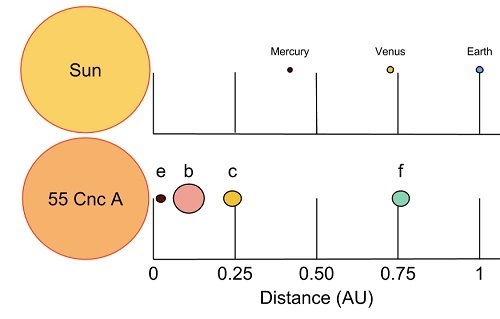
Image: An illustration of the orbital distances and relative sizes of the four innermost planets known to orbit the star 55 Cancri A (bottom) in comparison with planets in own inner Solar System (top). Both Jupiter and the Jupiter-mass planet 55 Cancri “d” are outside this picture, orbiting their host star with a distance of nearly 5 astronomical units (AU), where one AU is equal to the average distance between the Earth and the Sun. Credit: Center for Exoplanets and Habitable Worlds, Penn State University.
First discovered to be orbited by a giant planet in 1997, 55 Cancri A has been the subject of numerous studies in the years since. We have five planets in total, one a cold gas giant evidently similar to Jupiter and in a similar orbit and another, of particular interest, a ‘super-Earth’ in close proximity to the host star. This world, 55 Cancri e, was thought until 2011 to orbit the star in three days, but astronomers then determined that its complete orbit took less than 18 hours. The software developed by Penn State graduate student Benjamin Nelson and Eric Ford (Penn State Center for Astrostatistics) has pegged the mass of 55 Cancri e at eight Earth masses.
A quick note on nomenclature: The formal designation for the innermost world here should be 55 Cancri A e, with the other planets referred to accordingly. I’m following the just published paper on this work in referring to it as 55 Cancri e, without reference to the distant M-dwarf.
The transiting world is now known to have a radius twice that of Earth and a density about the same as our planet. Another glance at the diagram shows that this is a world far too hot for life as we know it, reaching temperatures in the range of 2300 Kelvin. The computations of Nelson and Ford draw the details of 55 Cancri e out of the motions of the giant planets 55 Cancri b and c, worlds that although orbiting outside the orbit of 55 Cancri e are still located closer to the star than Mercury is to our Sun. The new techniques help us understand how large planets like these can orbit so close to their star without collision or the expulsion of one of the two worlds.
The motion of the inner giant planets has to be accounted for to measure the detailed properties of the ‘super-Earth,’ and Ford notes that most previous work on this system had ignored their interactions. Nelson explains the significance of understanding the stability of their orbits:
“These two giant planets of 55 Cancri interact so strongly that we can detect changes in their orbits. These detections are exciting because they enable us to learn things about the orbits that are normally not observable. However, the rapid interactions between the planets also present a challenge since modeling the system requires time-consuming simulations for each model to determine the trajectories of the planets and therefore their likelihood of survival for billions of years without a catastrophic collision.”
1418 hours of radial velocity observations from four observatories went into this work along with transit studies for 55 Cancri e, out of which orbital solutions stable for a minimum of 108 years emerge. The researchers evolved four- and five-planet models as they examined instabilities in the system, coupling their work with radial velocity observations to constrain the planet masses and orbital parameters that produce dynamically stable solutions. As the paper notes, “By combining a rigorous statistical analysis, dynamical model and improved observational constraints, we obtain the first set of five-planet models that are dynamically stable.” Another interesting finding: 55 Cancri d turns out to be “the closest Jupiter analog to date” in terms of orbital period and eccentricity.
The paper is Nelson et al., “The 55 Cancri Planetary System: Fully Self-Consistent N-body Constraints and a Dynamical Analysis,” Monthly Notices of the Royal Astronomical Society, published online 22 April 2014 (preprint). Also see this Penn State news release.






April 23, 2014
Envisioning Alien Worlds
How we conceive of distant worlds is important. After all, we want to be scientifically accurate even as we deal with subjects that fire the public imagination. Thinking about planets in the habitable zones of other suns invariably makes us think of ‘Earth 2.0’ and the prospect of green and blue planets filled with life. But each situation will be different, which is part of the great fascination of this quest. Billions and billions of worlds, each of them sui generis.
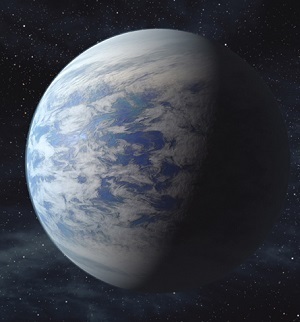
Science fiction has offered us glimpses of many worlds tantalizingly like the Earth but in some major respect different. Here, for example, is a prose description of a planet circling the star 82 Eridani, as envisioned by Stephen Baxter in his 2011 novel Ark. We are looking at it from the starship that has taken a band of colonists/refugees from a drowning Earth to what could be their new home:
A big strip of land stretching north to south across the equator was “the Belt,” a kind of elderly Norway with deep-cut fjords incising thousands of kilometers of coastline. The northern half of the Belt was currently ice-free, but its southern half, stretching into the realm of shadow, was icebound, and snow patches reached as far north as the equator. Sprawling across a good portion of the eastern hemisphere was the roughly circular continent they called “the Frisbee,” a mass of rust red broken by the intense blue of lakes and lined by eroded mountains. Its center was dominated by a huge structure, a mountain with a base hundreds of kilometers across, and a fractured caldera at the top. The mount was so like Olympus Mons on Mars that giving it the same name had been unavoidable, and it so dominated the overall profile of the continent, giving it an immense but shallow bulge, that the nickname “Frisbee” was a good fit. Then, to the west of the Belt, an archipelago sprawled, a widespread group of islands, some as large as Britain or New Zealand, that they called “the Scatter.” There was one more continent at the south pole, currently plunged in darkness and buried under hundreds of meters of winter snow, called “the Cap.” The world ocean itself had no name yet; the seas could be named when they were ready to go sailing on them…
Image: An artist’s concept of a habitable zone world, in this case Kepler-69c. This image is, of course, based on an actual Kepler discovery, though like Baxter’s science fictional description, it has to substitute imagination for detailed data. Credit: Ames Research Center/NASA, JPL-Caltech.
Baxter’s world is fascinating, a place the colonists assume is Earth 2.0 until they take a closer look. For one thing, there’s little tectonic activity here, so the kind of geological and biological cycling we take for granted on Earth has been, over the eons, sharply reduced. But the real showstopper is the planet’s obliquity, interesting to note in light of the University of Washington work on axial tilt that we looked at on Monday. This world around 82 Eridani shows an obliquity of ninety degrees — compare that to Earth’s 23.5 degrees. In other words, each part of the planet except for a band along the equator will suffer through months of perpetual darkness, then perpetual light.
Land and colonize such a world or press on for another? I won’t give away that decision, which Baxter handles in a believable and interesting way. But as we saw yesterday, there are models now emerging that show such a planet might make itself habitable by never developing truly global ice. In any case, imagine what life would be like on such a world, and ask yourself whether humans could adapt to it. The guess here is that they could, but the impetus for developing a migratory pattern of development would be profound.
The Kepler-186f Image
Spurring these thoughts was an email from Thomas Barclay, a research scientist working on the Kepler mission at NASA Ames. Tom writes the excellent Planet Hunter blog, which he used several days ago to explain How we designed the Kepler-186f artists concept image that I wrote about on Monday. I seldom post the same image several days running, but today is an exception since I want to relate that image to the entire issue of how we visualize alien planets. Here it is again:
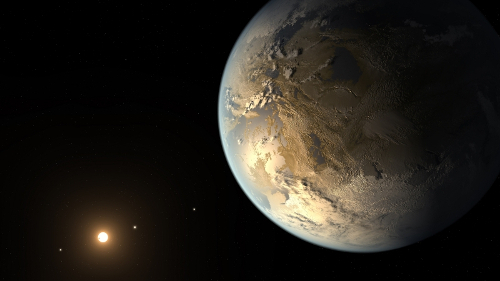
As I mentioned on Monday, this view — created by Tim Pyle and Robert Hurt (JPL/Caltech) — is a splendid piece of work, but you’ll recall that I wondered whether it wasn’t a bit too realistic, given that the public audience contains many who would assume we actually have this level of detailed information about the planet. The flip side of that question is to note how much care went into the image and what decisions were made given that we really know little beyond the size of the planet, the size and temperature of the star, and the distance between planet and star.
What I hadn’t really noticed was the star, Kepler-186, itself. It’s a red dwarf, but as you look at the image, you see that it’s much brighter than we might expect. What we know about Kepler-186 is that its temperature is about 3800 Kelvin. Now if you go to work on the spectrum of various star types and study the response of the human eye — check What color are the stars? for more — you’ll find that in the absence of any atmosphere, Kepler-186 would be yellow/orange in color. Tom writes that the team chose to make it a bit more orange in this image that it would actually appear to the eye, to get across the fact that the star is not truly like our G-class Sun.
Now look at the planet itself, which shows continents that are yellow and oceans in blue/grey. The ice caps as well as the clouds have an orange hue. Why these choices? Let me quote Tom on this:
This star emits very little blue light which we represented by making the sea a dull grey/blue color. Ice and clouds Mie scatter light [see this Wikipedia entry on Mie scattering] which is fairly uniform across all wavelengths hence clouds and ice appear the same color as the star. Then we come to the color of the continents – we had fun with this one. When we were designing the image Elisa Quintana found an article by Nancy Kiang titled The Color of Plants on Other Worlds. Nancy is a scientist based at NASA Ames (she moved to Ames from GISS the week after we talked to her, small world heh!) who works with the Virtual Planetary Laboratory. We called her up and chatted about what colors plants might be on planets orbiting cool stars. While this is a very complex issue involving evolution of photosynthesis, she recommended a dark yellow/green color as a potential color for alien planet life on this world.
And reminding us how little we know about this planet, Tom goes on to note that the artists chose to depict the planet as a bit colder than Earth, realizing that we have no knowledge about its atmosphere, which will have a great deal to say about its temperature. This was an educated guess to show a planet with prominent ice caps and plant life in the equatorial regions. It’s based on the understandable analogy with the Earth, which has the water, continents and clouds we see in this image translated to a hypothetical planetary body around another star.
So am I being too fussy in talking about people getting the wrong idea from such images? Maybe so, in the sense that along with the excellent artwork, we have to be careful to get the message out about what we actually know about the world. I think Tom gets it right when he says “Hopefully this image provides a nice tool to explain what might be the same and what might be different between this planet and Earth.” Making those explanations is a job for those of us who try to communicate the findings of our exoplanet hunters to the general public, and it’s something we need to do well to separate the genuine excitement of the work from the frequent media hype.






April 22, 2014
Enter the ‘Anti-Transit’
Gravitational lensing is a technique rich enough to help us study not only distant galaxies but exoplanets around stars in our own Milky Way. As gravity warps space and time, light passing near a massive object takes the shortest route, from our perspective seeming to be bent by the gravitational field. Inside the Milky Way, such effects are referred to as ‘microlensing,’ capable of magnifying the light of a more distant object and sometimes revealing the presence of an unseen planet around the intervening star. Now we have a Kepler find with implications for binary stars.
Working with Eric Agol at the University of Washington, graduate student Ethan Kruse has discovered a ‘self-lensing’ white dwarf eclipsing binary system. He made the find while looking for transits in the Kepler data, the signatures of planets crossing in front of their stars as seen from Earth. KOI-3278 turned out to have an unusual signal, says Kruse:
“I found what essentially looked like an upside-down planet. What you normally expect is this dip in brightness, but what you see in this system is basically the exact opposite — it looks like an anti-transit.”
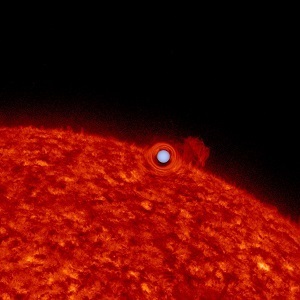
In other words, a transiting planet causes a dip in the overall light of the star that shows up in the well known lightcurves that have flagged the presence of so many Kepler planets. Kruse was seeing not a dip but a surge in brightness, the apparent result of movement within this binary star system. 2600 light years away in the constellation Lyra, KOI-3278 is now known to be made up of two stars with an orbital period of 88.18 days, one of them a white dwarf, separated by about 70 million kilometers. The brightness surge is the white dwarf’s lensing effect upon the star it passes in front of as we view the system. The lensing effect allows the mass of the white dwarf to be measured as roughly 63 percent the mass of our Sun.
Image: An image of the Sun used to simulate what the sun-like star in a self-lensing binary star system might look like. Credit: NASA.
It was about a year ago that Philip Muirhead (Caltech) and colleagues published their own findings, likewise based on Kepler data, of a white dwarf being orbited by an M-class dwarf that was, although larger, less massive than the white dwarf it circled. KOI-256 looked at first glance to show the signature of a gas giant planet eclipsing the red dwarf, but radial velocity follow-up studies using the Hale instrument at Palomar Observatory demonstrated that the intervening object was a white dwarf. The KOI-256 data showed the same brightening effects that Kruse found with KOI-3278, although the microlensing in the former was not nearly as powerful.
In both cases, refined mass measurements of the white dwarf have followed, as well as more accurate analysis of the mass and temperature of both stars. Kruse and Agol think the effect can be used in follow-up observations to reveal the white dwarf’s size, and have applied for time on the Hubble Space Telescope to study the system in greater detail. We may or may not find more systems like this in the Kepler data, but the KOI-3278 discovery gives us yet another way to use the extremely subtle effects of microlensing. In this case, the lensing is a repeatable phenomenon as the two stars orbit each other, not the case with most microlensing events.
The paper is Kruse and Agol, “KOI-3278: A Self-Lensing Binary Star System,” Science Vol. 344, No. 6181 (18 April 2014), pp. 275-277 (abstract). The KOI-256 paper is Muirhead et al., “Characterizing the Cool KOIs. V. KOI-256: A Mutually Eclipsing Post-Common Envelope Binary,” The Astrophysical Journal Vol. 767, No. 2 (2013), 111 (abstract).






April 21, 2014
Two Takes on Habitability
Last week’s announcement about Kepler-186f presented a world that is evidently in the outer reaches of its star’s habitable zone, with the usual caveats that we know all too little about this place to draw any conclusions about what is actually on its surface. Is it rocky, and does it have liquid water? Perhaps, but as Greg Laughlin (UC-Santa Cruz) points out on his systemic site, the widely circulated image of Kepler-186f was all but photographic in its clarity. Listen to Laughlin as he looks at the image:
I stared at it for a long time, tracing the outlines of the oceans and the continents, surface detail vivid in the mind’s eye. Yes, ice sheets hold the northern regions of Kepler-186f in an iron, frigid grip, but in the sunny equatorial archipelago, concerns of global warming are far away. Waves lap halcyon shores drenched in light like liquid gold.
He goes on to look at how the press has handled earlier stories on habitable planets, dating back to the Gliese 581c frenzy of 2007. And you can see the evolution in artist’s renderings of the various worlds under discussion, culminating in a Kepler-186f image that could indeed be misconstrued as a photograph by someone who didn’t realize the limits of our capabilities. Here’s the image again (credit: NASA Ames/SETI Institute/JPL-Caltech):

It’s beautiful work, and I ran it last Thursday along with my story on the new planet. But we have to be careful not to get too far ahead of ourselves. Yes, researchers tracking the exoplanet hunt understand that this is entirely conjectural, but upon reflection, I think we’re sending a signal to the general public that we’re more confident about what these worlds are like than is justified. In the case of Kepler-186f, the fact that a planet is close to Earth-sized does not render it Earth’s twin in any other meaningful way, especially given that the planet orbits a red dwarf and pulls in only about a quarter of the insolation that Earth receives.
The Benefits of Axial Tilt
What we do surmise about habitable zones keeps getting tweaked around the edges, and on a more theoretical plane, the work on planets with ‘tilted’ orbits — this comes out of the University of Washington, Weber State and NASA — is intriguing because it pushes liquid water on the surface much further out than earlier habitable zone notions would allow. The paper, which appears in the April Astriobiology may, in fact, expand the habitable zone by ten to twenty percent, which would greatly increase the number of planets suitable for life.
We’re talking about planets whose axis has been tilted from their orbital plane thanks to gravitational interactions with other planets in the system. The contention here is that a fluctuating tilt in a planet’s orbit may enhance rather than diminish the chances for life, because glaciation becomes more difficult when polar regions melt thanks to the erratic spin. Says Rory Barnes (University of Washington), “…the rapid tilting of an exoplanet actually increases the likelihood that there might be liquid water on a planet’s surface.” From the paper:
We interpret our results to mean that planets with large and rapid obliquity oscillations are more likely to be habitable than those with negligible oscillations, such as the Earth. This perspective is at odds with the notion that the stability of the Earth’s obliquity is important to the development of life. While it still may be true that rapid oscillations can be detrimental, and certainly at some point obliquity cycles could be too large and rapid, our results clearly show that rapid obliquity evolution can be a boon for habitability. At the least, one should not rule out life on planets with rapid obliquity cycles.
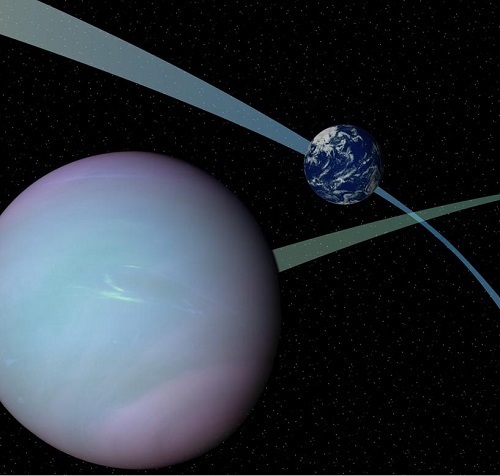
Image: Tilted orbits such as those shown might make some planets wobble like a top that’s almost done spinning, an effect that could maintain liquid water on the surface, thus giving life a chance. Credit: NASA/GSFC.
One consequence is that future searches for living planets might be extended farther from the target star, given the deeper habitable zone available, a result with a bearing on how difficult it is to separate stellar and reflected planetary light. The researchers do point out in their conclusion that their simulations all began with planetary spin rates of 24 hours and obliquities of 23.5 degrees, clarifying the need for future work on a wider range of initial conditions. In particular, does a specific solar system ‘architecture’ always produce a particular obliquity cycle?
Interesting stuff, and bear in mind that it could have ramifications on another theory, that planets need a large, stabilizing moon to be suitable for life. The Earth’s axial tilt of 23.5 degrees would, in the absence of Luna, increase to the point where climate fluctuations became more extreme. This could be problematic for planets in orbits like ours, but at the outer edge of the habitable zone, in this view, those fluctuations could be precisely what is needed to prevent ice from becoming global, making the lack of a moon is a distinct plus. Large moons, then, may have a role to play in both directions, depending on the planet’s position in the habitable zone.
The paper is Armstrong et al., “Effects of Extreme Obliquity Variations on the Habitability of Exoplanets,” Astrobiology Vol. 14, Issue 4 (April 15, 2014), full text available. The University of Washington press release is here.






April 18, 2014
An Outward-Looking Grand Strategy
We use strategies to weigh the issues around us and maximize our chances for success. Can we create a strategy not just for a specific short-term goal but for the survival and growth of our entire species? In the essay that follows, Michael Michaud looks at the elements of such a vision, one that by necessity takes us out of our own biosphere and into the cosmos. As long-time Centauri Dreams readers know, Michaud is well suited to discussing the resolution of conflict and the attainment of goals. His lengthy career in the U.S. Foreign Service led to posts as Counselor for Science, Technology and Environment at U.S. embassies in Paris and Tokyo, and Director of the State Department’s Office of Advanced Technology. He has also been chairman of working groups at the International Academy of Astronautics on SETI issues, and is the author of the highly regarded Contact with Alien Civilizations: Our Hopes and Fears about Encountering Extraterrestrials (Springer, 2007).
By Michael A.G. Michaud

We are living amid four revolutions that draw human minds beyond the limits of the Earth.
* Astronomical exploration of the cosmos by ground-based instruments, orbiting observatories, and robotic spacecraft brings the rest of our solar system closer to us, so that we can more realistically consider living on or utilizing other worlds.
* Human spaceflight enables us to expand our presence and our field of action beyond the Earth. It changes the way we see our position in the cosmos, implying that we – and our prospects for the future — need not remain confined to our home planet.
* The search for extraterrestrial life and intelligence changes our perspective on the role of biology and sentience in the universe. Life may prove to be a widespread phenomenon, not unique to the Earth. Contact with another civilization might challenge us, or open up vast opportunities for our species.
* Proposals for extraterrestrial macroengineering , such as mining the Moon and the asteroids, building satellite solar power stations, and terraforming Mars, could enable us to expand our influence on matter and energy beyond the Earth, utilizing those resources to remove the limits to growth and open up new options for our species.
These revolutions broaden Earth-bound conceptions. They urge us to reach outward. They imply grand shared tasks for Humankind.
These revolutions also contrast us to an outside, heightening our awareness that we spring from a common origin and live in a common biosphere. They encourage us to think about the shared interests of humankind.
Synergy
Astronomy, planetary exploration, and human spaceflight are not mutually exclusive. Work in one field has stimulated new ideas – and sometimes new programs and more funding – in others.
Astronomy has been a powerful stimulus to thinking about spaceflight. It has given us a better understanding of potential destinations, and potential risks.
This can work both ways. Astronomy and planetary exploration would not have enjoyed the growth they experienced during after the beginning of the space age had it not been for the Moon landing program and the prospect of eventual human missions to Mars.
We find stimulus and response elsewhere too. The search for extraterrestrial life has been a major factor in gaining support for planetary exploration missions to Mars. The possible presence of oceans under the ice of outer planet moons is stimulating new interest. SETI, a search for evidence of alien technology, grew out of radio astronomy.
Ideas about bases on the Moon and Mars became more credible after human and robotic missions gave us geological information about lunar and planetary materials. Extraterrestrial macroengineering concepts such as mining or diverting asteroids help justify further exploration of our solar system.
Discovering planets around other stars has given new impetus to astrobiology, SETI and interstellar exploration by robotic probes.
Those who support the implementation of these grand ideas have learned to play politics, to lobby for their causes in national capitals and multinational organizations. Their efforts have concentrated on budget processes, encouraging a near term approach. Political persuasion has focused on funding specific projects.
Instead of seeing the competition for funding as a zero-sum game, we could make a more conscious effort to see connections and seek synergisms. To cite one example, ground-based astronomers have been surveying asteroids that cross or come near the orbit of the Earth. Unmanned missions to asteroids and comet nuclei might pave the way for human exploration. Those in turn could assist in developing mining operations, making those bodies part of the human resource base.
If separate advocacies worked together, the whole might be greater than the sum of its parts. What is missing is a unifying concept.
A Grand Extraplanetary Strategy
All of these fields of human endeavor are parts of an unarticulated grand strategy for our species.
At the most basic level, a strategy is simply a thoughtful way of dealing with one’s environment to improve one’s prospects for success. A grand strategy for the human species would be one designed to improve our ability to survive, to grow, to diversify, and to increase our influence on our environment and our future.
There are many elements to such a strategy, including the better management of our resources, reducing undesirable impacts on our biosphere, limiting conflict among humans, and maintaining the conviction that our future can be better than our past. Most conceptions constrain the design of such a strategy to the biosphere of our origin – a stage that many find unnecessarily narrow. The environment of a technological species is much larger than the planetary biosphere that gave it birth.
Here we may have the common purpose that underlies the four outward-looking revolutions of our time. Astronomy, planetary exploration, and SETI are reconnaissances of our larger environment. They are essential elements of any rational extraplanetary strategy for the human species; without them, we could not conduct intelligent operations beyond the Earth.
Human spaceflight is partly for reconnaissance and partly for operations, depending on the objectives of particular missions. Extraterrestrial mining and macaroengineering, including the building of large structures in space, clearly would be operations.
Whatever our differences about specific missions may be, we could share a broad vision of human activity beyond the Earth, placing astronomy, planetary spaceflight, SETI, and proposals for extraterrestrial macroengineering in a common context.
Hard times can produce new alliances. Instead of seeing other programs as rivals for funding, we could look for opportunities for each to help the others, designing missions to be synergistic wherever that is possible. For example, advocates of interstellar exploration by probes could more actively support the search for extrasolar planets and invite extrasolar planet seekers to reciprocate.
This approach will not lead to quick miracles in public funding. Governments and international organizations are unlikely to adopt a formal extraplanetary strategy, or even to agree that we should have one. But they might respond to tactical alliances among the revolutionaries.
Many differences may divide us, but we can share a unifying idea: that we are participating in the definition and implementation of a grand strategy for our species.
Armed with a shared vision, we can work quietly and persistently to see that the parts of such a grand strategy are put into place, supporting each other whenever possible. That will require patience, and an enlightened sense of self-interest.
Separately, we have worked wonders. Imagine what we could do together.
——-
This essay is based on three documents written more than thirty years ago. The author first presented a paper on this subject at the 1981 International Astronautical Congress in Rome. A more detailed discussion can be found in “Towards a Grand Strategy for the Species,” Earth-Oriented Applications of Space Technology, Vol. 2, No. 3-4 (1982), 213-219. A simpler, more popularized version entitled “Sharing the Grand Strategy” appeared in Space World, August 1984, 5-9.






April 17, 2014
Kepler-186f: Close to Earth Size, in the HZ
We have another ‘habitable zone’ planet to talk about today, one not much bigger than the Earth, but it’s probably also time to renew the caveat that using the word ‘habitable’ carries with it no guarantees. The working definition of habitable zone right now is that orbital distance within which liquid water might exist on the surface of a planet. Whether it actually does is just one of the questions. A second is whether or not we’re in fact dealing with a rocky terrestrial world.
So Centauri Dreams approaches the announcement of Kepler-186f with guarded enthusiasm for an exoplanet that looks interesting indeed. Five planets circle this star, an M-dwarf a great deal smaller and cooler than the Sun. Discovered by the Kepler space observatory, the planet presents us with transit information telling us that it is about 1.1 Earth radii, although we don’t yet know what the mass of this world is, and hence can’t make a definitive call on whether or not it is rocky. But Stephen Kane (San Francisco State), one of the researchers involved in today’s announcement, thinks we have reason to think that it is:
“What we’ve learned, just over the past few years, is that there is a definite transition which occurs around about 1.5 Earth radii,” said Kane. “What happens there is that for radii between 1.5 and 2 Earth radii, the planet becomes massive enough that it starts to accumulate a very thick hydrogen and helium atmosphere, so it starts to resemble the gas giants of our solar system rather than anything else that we see as terrestrial.”
Kepler-186f is thus well below the value where we would expect it to accumulate a thick hydrogen and helium envelope, causing Kane to add “there’s a very excellent chance that it does have a rocky surface like the Earth.” If that’s the case, then we have a planet on the outer edge of its star’s habitable zone, though one that may have a somewhat thicker atmosphere than Earth’s because of its somewhat larger size. Perhaps the surface can avoid freezing. In any case, this is what lead author Elisa Quintana (NASA Ames) calls “the first definitive Earth-sized planet found in the habitable zone around another star.” The work appeared today in Science.

Image: The artist’s concept depicts Kepler-186f, the first validated Earth-size planet orbiting a distant star in the habitable zone—a range of distances from a star where liquid water might pool on the surface of an orbiting planet. The discovery of Kepler-186f confirms that Earth-size planets exist in the habitable zone of other stars and signals a significant step closer to finding a world similar to Earth. Credit: NASA Ames/SETI Institute/JPL-Caltech.
The discovery team used so-called ‘speckle imaging’ in obtaining its high resolution observations from the eight-meter Gemini North telescope on Mauna Kea as well as adaptive optics observations from the ten-meter Keck II telescope to rule out extraneous sources that could account for the Kepler data, concluding that the signal has to be that of a transiting planet. The speckle data allowed direct imaging of the system to within 400 million miles, confirming there were no other stellar-sized objects orbiting within this distance from the star. “The Keck and Gemini data are two key pieces of this puzzle,” adds Quintana. “Without these complementary observations we wouldn’t have been able to confirm this Earth-sized planet.”
The new planet orbits its star once every 130 days, receiving about a third of the heat energy that Earth does from the Sun. The four inner planets — Kepler-186b, Kepler-186c, Kepler-186d, and Kepler-186e — are all too hot for life as we know it, with periods of 3, 7, 13 and 22 days.
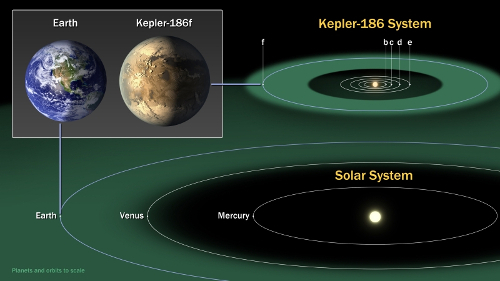
Image: Kepler-186 and the Solar System: The diagram compares the planets of the inner solar system to Kepler-186, a five-planet system about 500 light-years from Earth in the constellation Cygnus. The five planets of Kepler-186 orbit a star classified as a M1 dwarf, measuring half the size and mass of the sun. The Kepler-186 system is home to Kepler-186f, the first validated Earth-size planet orbiting a distant star in the habitable zone—a range of distances from a star where liquid water might pool on the surface of an orbiting planet. Credit: NASA Ames/SETI Institute/JPL-Caltech.
The objection to Kepler-186f as a home for life rests on the dangers of orbiting an M-dwarf, a class of star prone to flare activity. Move a planet close enough to the star to be in its habitable zone and the assumption is that it’s also tidally locked, presenting the same side to the star throughout its orbit, with all the complications that brings to climate models. Neither of these factors are complete show-stoppers — some climate studies show that temperature extremes can be mitigated by winds or ocean currents — and in the case of Kepler-186f, we do have a world on the habitable zone’s outer edge, perhaps far enough out not to suffer tidal lock.
So it’s an interesting place, this new world, about 490 light years away in the constellation Cygnus and thus tantalizingly out of reach for atmospheric analysis even with instrumentation planned for the near future. The James Webb Space Telescope itself won’t be able to help us with that task. But it’s pleasing to note that Kepler-186f has been studied over a frequency range of 1 to 10 GHz looking for emissions, though none has so far been found. Getting a detectable signal here from this star would require a transmitter between 10 and 20 times as powerful as the planetary radar system at Arecibo. SETI keeps coming up empty, but good for us if, in addition to our other studies, we keep our ears open for a long-shot detection.
The paper is Quintana et al., “An Earth-Sized Planet in the Habitable Zone of a Cool Star,” Science Vol 344, No. 6181 (18 April 2014), pp. 277-280 (abstract). This news release from from the Gemini and Keck observatories is also helpful.






April 16, 2014
A New Look at Sea Floor Astrobiology
How do you produce life on an early Earth bathed in ultraviolet radiation? The presumption when I was growing up was that the combination of chemicals in ancient ponds, fed energy by lightning or ultraviolet light itself, would produce everything needed to start the process. Thus Stanley Miller and Harold Urey’s experiments, beginning in 1953 at the University of Chicago, which simulated early Earth conditions to produce amino acids out of a sealed ‘atmosphere’ of water, ammonia, methane and hydrogen, with electrodes firing sparks to simulate lightning.
But there are other ways of explaining life’s origins, as a new study from the Jet Propulsion Laboratory and the Icy Worlds Team at the NASA Astrobiology Institute reminds us. Hydrothermal vents on the sea floor have been under consideration since the 1980s, with some researchers pointing to the ‘black smokers’ that produce hot, acidic fluids. The new NASA work looks at much cooler vents bubbling with alkaline solutions like those in the ‘Lost City,’ a field of hydrothermal activity in the mid-Atlantic on the seafloor mountain Atlantis Massif.
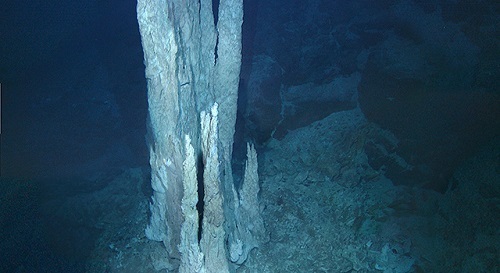
Image: This image from the floor of the Atlantic Ocean shows a collection of limestone towers known as the “Lost City.” Alkaline hydrothermal vents of this type are suggested to be the birthplace of the first living organisms on the ancient Earth. Credit: JPL.
Here there is a field of about thirty large calcium carbonate chimneys — some 30 to 60 meters tall — and a number of smaller structures venting mainly hydrogen and methane into the surrounding water. The so-called ‘water world’ theory that JPL’s Michael Russell has been working on since 1989 draws on the idea that warm alkaline vents like these would have maintained a state of imbalance with ancient oceans that were acidic. Life is, in this formulation, seen as the inevitable outcome of disequilibrium, producing enough energy to drive its formation.
Thus we have a proton gradient with hydrogen ions concentrated largely on the outside of the vent’s chimneys, which the work refers to as ‘mineral membranes.’ We also have an electrical gradient between oceans rich with carbon dioxide. and hydrogen and methane from the vents as they meet at the chimney wall. The transference of electrons could have produced complex organic compounds, using processes not so different from those that occur in mitochondria.
“Within these vents, we have a geological system that already does one aspect of what life does,” said Laurie Barge, second author of the study at JPL. “Life lives off proton gradients and the transfer of electrons.”
The work represents a fundamental shift in focus over older ‘chemical soup’ models, its examination of membrane-spanning gradients pre-empting prebiotic chemistry. The paper explains:
…there is an advantage to be gained from examining the transition from geochemistry to biochemistry from the bottom up, that is, to “look under the hood” at life’s first free energy–converting nanoengines or “mechanocatalysts.” Such an approach encourages us to see life as one of the last in a vast hierarchical cascade of emergent, disequilibria-converting entropy-generating engines in the Universe. In doing so, we keep our sights on the “astro” in astrobiology.
The researchers speculate that minerals may have played the role of enzymes in the ancient ocean, interacting with local chemicals and driving reactions. A mineral called ‘green rust’ (fougèrite) could use the proton gradient to produce phosphate-laden molecules capable of storing energy. Molybdenum is also in play, a rare metal that can drive important chemical reactions. Thus basic metabolic reactions around sea floor hot springs may help to explain not only how life emerged on our own planet but also how it may emerge on worlds far beyond.
On this latter point, the paper explains how to proceed:
In considering habitability and the potential for life elsewhere in the Solar System and beyond, the physical and chemical disequilibria that obtain on wet icy rocky worlds, and the various processes that might relieve them, need to be established. If life’s origin is ultimately coupled to geophysical convection in a particular geochemical context, one should be able to make predictions about life’s likelihood on a planet or moon of interest from application of coupled chemical and fluid/geodynamical modeling, and from the availability of key feedstocks, thus accounting for other planetary energetic drivers, for example, tidal and radiogenic heating, solar wind interactions, magnetic dynamos—appropriate to the object in question.
We’d like to account, in other words, for the disequilibrium-producing factors that could play an astrobiological role on multitudes of exoplanets. The possibilities range widely, from gravitational effects to thermal and chemical gradients that can all play a role in life’s inception. Particularly close to home, of course, we focus in on places like Enceladus and Europa, where we have nearby laboratories for observing these processes in action. Until we can put the right kind of instrumentation on the scene, continuing Earth-bound lab work on these ideas is the way forward.
The paper is Russell et al., “The Drive to Life on Wet and Icy Worlds,” Astrobiology Vol. 14, Issue 4 (April 15, 2014). Available online. A JPL news release is also available.






April 15, 2014
Saturn: Commotion in the A Ring
After yesterday’s look back at the ambitious Project Orion planners and their hopes of reaching Saturn’s moons by the 1970s, let’s stay in the same vicinity today to look at what may be the emergence of an entirely new moon. As always, we have Cassini to thank for this work, which shows a disturbance at the outer edge of Saturn’s A ring. This is the outermost of the large, bright rings, with a width of approximately 14,600 kilometers. Its inner boundary is the Cassini division, a 4800 kilometer wide region between it and the B ring.
The image below shows the disturbance, an area in the shape of an arc that is about 20 percent brighter than its surroundings. The region is some 1200 kilometers long and 10 kilometers wide, and it is accompanied by breaks in the otherwise smooth profile at the edge of the ring. The current thinking is that both the arc and the protuberances are the result of gravitational effects caused by a nearby object. Are the rings, then, giving birth to a new moon?
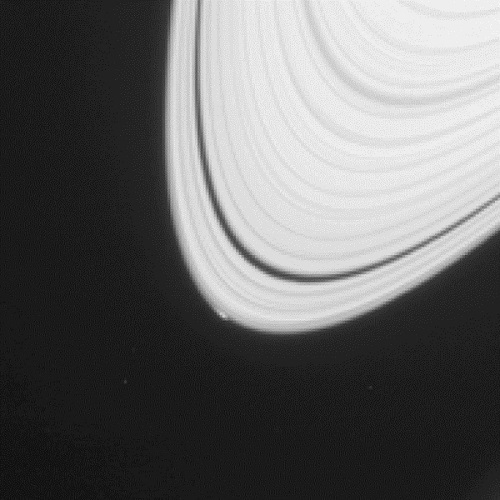
Image: The disturbance visible at the outer edge of Saturn’s A ring in this image from NASA’s Cassini spacecraft could be caused by an object replaying the birth process of icy moons. This view looks toward the illuminated side of the rings from about 53 degrees above the plane of the rings. It was obtained from a distance of approximately 775,000 miles (1.2 kilometers) from Saturn, with a sun-Saturn-spacecraft, or phase, angle of 31 degrees. The scale is about 7 kilometers per pixel. Credit: NASA/JPL-Caltech/Space Science Institute.
Informally dubbed ‘Peggy,’ the proto-moon, assuming that is what it is, cannot yet be resolved in Cassini’s imagery, although the spacecraft will move closer to the outer edge of the A ring in late 2016, perhaps offering an opportunity to study it in greater detail. Scientists estimate it to be no more than a kilometer in diameter, but the diminutive object could give us the chance to shake out a recent proposal that all the icy moons formed originally from ring particles before moving further away from the planet, growing over time as they merged with other moons.
“The theory holds that Saturn long ago had a much more massive ring system capable of giving birth to larger moons,” said Carl Murray (Queen Mary University, London), lead author of the paper on this work. “As the moons formed near the edge, they depleted the rings and evolved, so the ones that formed earliest are the largest and the farthest out.”
Many of Saturn’s moons are composed largely of ice, and they do indeed increase in size with distance from the planet. “We may,” adds Murray, “be looking at the act of birth, where this object is just leaving the rings and heading off to be a moon in its own right.”
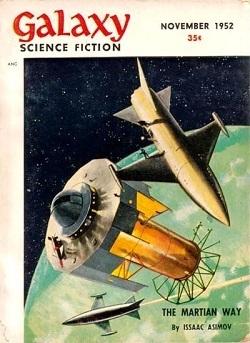
This news combined with the thought of using Enceladus to refuel a Project Orion vessel, as we discussed yesterday, somehow calls to mind Isaac Asimov’s story “The Martian Way,” a novella first published in Galaxy Science Fiction (1952) and later made available in The Martian Way and Other Stories (1955). Martian colonists make the trip to Saturn to bring back a cubic mile of ice that will supply the colony for 200 years. They, embed their ships in the ice block for the return even as they use its resources as reaction mass.
Martians, it turns out, are the perfect crew for deep space vehicles because — Gerald Driggers, author of the Earth-Mars Chronicles, will like this — they’ve been forced to acclimatize to cramped conditions and the rigors of space travel. Asimov’s characters look down upon the unfortunate planet-bound population of Earth and discuss what they see as an inevitable future:
“Even if they come to Mars, it will only be their children that are free. There’ll be starships someday: great huge things that can carry thousands of people and maintain [their] self-contained equilibrium for decades, maybe centuries. Mankind will spread through the whole Galaxy. But people will have to live their lives out on shipboard until new methods of interstellar travel are developed, so it will be Martians, not planet-bound Earthmen, who will colonize the Universe. That’s inevitable. It’s got to be. It’s the Martian way.”
The new work on the A-ring anomaly is Murray et al, “The discovery and dynamical evolution of an object at the outer edge of Saturn’s A ring,” published online by Icarus, 28 March 2014 (abstract).






April 14, 2014
Remembering ‘Saturn by 1970′
One day in the late summer of 1958, at a time when the Jet Propulsion Laboratory was still in the hands of the U.S. Army (the transfer to NASA wouldn’t happen until the end of that year), Freeman Dyson and Ted Taylor showed up at the facility outside Pasadena. Try to imagine the scene: At the time, JPL was busy building the Explorer 6 satellite, all 65 kilograms of it. And here came two Project Orion scientists talking about not just satellites but auxiliary vehicles, additional payload to fly aboard their proposed 4000 ton spacecraft that they hoped would explore the outer planets.

“The reception there was rather cool,” Dyson would later say. “The lady at the front office decided Taylor and I were a pair of crackpots and tried to get rid of us. After about half an hour of arguing we got inside and then it all went very well.”
Image: Freeman Dyson, whose payload ideas must have confounded the team working on early Earth satellites. Credit: Courtesy of Princeton University Archives. Princeton University Library.
The entertaining tale is told in George Dyson’s Project Orion: The True Story of the Atomic Spaceship (Henry Holt, 2002), and it’s easy to see why even hardened rocket scientists would be confounded by what the duo proposed. By mid-1958, the largest payload ever lifted into orbit was Sputnik III, weighing in at 1325 kilograms. Project Orion was intended to loft 1600 tons to low-Earth orbit, or in its advanced version, 1300 tons to a landing on one of Saturn’s moons. The moon that most drew Dyson’s eye in 1958 was tiny Enceladus.
When I wrote about this in connection with the recent findings of an ocean within the distant moon, I was delighted to receive the diagram below from George Dyson, which shows the numbers as tabulated by Freeman Dyson in 1958, when details about the outer planets’ moons were sketchy at best. I want to run this as a bit of deep space history, the working figures that would later turn into Freeman Dyson’s document “Trips to Satellites of the Outer Planets, which was declassified in 1987.

Image: Thinking about deep space destinations in 1958, as the Orion team pondered their best options for a trip that might take place as early as 1970. Credit: Freeman Dyson, courtesy of George Dyson.
With reference to the figures, George Dyson comments:
“Note that the .618 density for Enceladus was not a transcription or arithmetic error, it is due to the mass and radius of the outer planet satellites being known only approximately at that time. (I believe Thomas “Tommy” Gold was brought in as a consultant on the question of selecting landing sites.) These calculations were made to determine the best destination both in terms of an optimum velocity match and highest probability of being able to obtain water ice or hydrocarbons on the surface to replenish the vehicle’s propellant mass.”
Below is the title page of the “Trips to Satellites of the Outer Planets’ report.

Image credit: Freeman Dyson, courtesy of George Dyson.
We’ve discussed Orion many times in these pages, though it’s been long enough that it may be time for a general review in the near future. Most Centauri Dreams readers will be familiar with George Dyson’s definitive book on the project’s history, and with the overall concept of detonating nuclear devices behind the craft, with a system of pusher plates and shock absorbers to cushion the crew, and the capability of launching payloads that were mind-boggling in the days of Sputnik. Interestingly, Mars was the first destination the team had in mind, though a landing on the Moon along the way would have been part of that mission. A four or five year mission seemed a possibility, one that Freeman Dyson would liken to the voyage of Darwin’s Beagle.
But the allure of the outer planets and their satellites was hard to resist, particularly when you threw in two ways to make the mission lighter and more efficient. For one thing, it was possible to use atmospheric braking (‘aerobraking’) to reduce propellant mass. I’ll quote from George Dyson’s book on the other:
The second part of the strategy is to gather propellant for the return trip at the destination, thereby reducing the average takeoff weight of the bombs. “We assume that we can use as propellant either ice, ammonia, or hydrocarbons,” wrote Freeman, explaining why Enceladus was such a good place to stop. “We suppose that each propulsion unit contains one-third of its mass in the form of the bomb and other fabricated parts, and two-thirds of its mass in the form of propellant. This means that, when propellant refueling is possible, only one-third of the mass required for the homeward trip need be carried out from Earth.” When you put these numbers together, the end results were astonishing. “With the use of atmospheric drag a round-trip to satellites of either Jupiter or Saturn could be made with a total velocity increment of the order of 40 km/sec. With refueling and braking, all the satellites become accessible with a round-trip mass-ratio less than 2.”
The Mars ship can thus become an outer planet ship that refuels along the way. And given the document shown above, I have to close with this last quote from the book:
Forty years later, Freeman and I review a two-page handwritten General Atomic calculation sheet, “Outer Planet Satellites,” dating from 1958 or 1959. It lists, for nine different satellites, ten different parameters such as orbital velocity, escape velocity, density, and gravity that determine the suitability of the satellites as places to land. Freeman smiles as he carefully studies the numbers.
“Enceladus still looks good,” he says.






April 11, 2014
Digging into the Late Heavy Bombardment
The Barberton greenstone belt is considered one of the oldest pieces of continental crust on the planet. About 100 kilometers long and 60 kilometers wide, the belt is in South Africa east of Johannesburg and not far from the border of Swaziland, a region where gold was first discovered in South Africa. Greenstone belts, however, are numerous, widely distributed geographically and throughout geological history, all of them marked by the characteristic green hue imparted by the metamorphic minerals within their rocks. The Barberton greenstone belt is now yielding evidence of a massive ancient impact well over three billion years old.
The paper on this work is slated to appear in the journal Geochemistry, Geophysics, Geosystems, where scientists will make the case that the impact they are tracking occurred 3.26 billion years ago at the end of the Late Heavy Bombardment, a period between three and four billion years ago when numerous large asteroids are thought to have struck the planet. The impact may have caused a major shift in plate tectonics, and characterizing it will help us better understand the conditions life struggled against in its earliest evolution.
It is possible that changes to the environment caused by impacts like this one may have wiped out existing microscopic organisms, only to allow other organisms to evolve. What’s mind-boggling here is the sheer size of the event. Have a look at the graphic below, and note in particular the comparison of the impact crater to the island of Hawaii.

Image: A graphical representation of the size of the asteroid thought to have killed the dinosaurs, and the crater it created, compared to an asteroid thought to have hit the Earth 3.26 billion years ago and the size of the crater it may have generated. A new study reveals the power and scale of the event some 3.26 billion years ago which scientists think created geological features found in a South African region known as the Barberton greenstone belt. Credit: American Geophysical Union.
The asteroid, according to this American Geophysical Union news release, would have been three to five times larger than the Chicxulub impactor considered to have played a huge role in the extinction of the dinosaurs. Striking the Earth at 20 kilometers per second, the object would have created a crater nearly 500 kilometers across, a larger jolt than a 10.8 magnitude earthquake, creating tsunamis thousands of meters deep. The researchers believe the sky would have become red hot and the tops of the oceans would have boiled.
“We are trying to understand the forces that shaped our planet early in its evolution and the environments in which life evolved,” said Donald Lowe, a geologist at Stanford University and a co-author of the study. As to the asteroid itself, Lowe added, ““We knew it was big, but we didn’t know how big.” The team’s model shows that while the Chicxulub event is estimated to have released a billion times more energy than the Hiroshima and Nagasaki bombs, this more ancient impact would have been far more powerful, and it was just one of many in the Late Heavy Bombardment.
The actual site of most of the impacts during the LHB is unknown, the victim of erosion, crustal movement and evolving geology, and the researchers believe the asteroid they are studying impacted thousands of kilometers away from the Barberton greenstone belt, though its seismic waves would have been responsible for the geological formations found in the region. Clearly the early Solar System was a chaotic and dangerous place, one in which the great experiment of life was under continuous threat. To map an impact that occurred more than three billion years ago is to chart the dimensions of ancient catastrophe, a time when vaporized rock fell as rain.
The paper is Sleep et al., “Physics of crustal fracturing and chert dike formation triggered by asteroid impact, ~3.26 Ga, Barberton greenstone belt, South Africa,” to be published in Geochemistry, Geophysics, Geosystems (abstract).






Paul Gilster's Blog
- Paul Gilster's profile
- 7 followers



